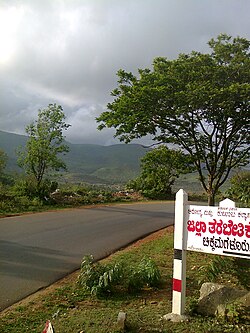Kaduru
|
Kadur ಕಡೂರು |
|
|---|---|
| Taluk | |

Kadur Road
|
|
| Location in Karnataka, India | |
| Coordinates: 13°33′12″N 76°00′41″E / 13.553345°N 76.011260°ECoordinates: 13°33′12″N 76°00′41″E / 13.553345°N 76.011260°E | |
| Country |
|
| State | Karnataka |
| District | Chikkamagaluru |
| Elevation | 763 m (2,503 ft) |
| Population (2001) | |
| • Total | 200,802 |
| Languages | |
| • Official | Kannada |
| Time zone | IST (UTC+5:30) |
| PIN | 577548 |
| Vehicle registration | KA-66 |
Kadur is a Taluk in Chikkamagaluru district, in Karnataka with an area of 2,813 m2 (30,280 sq ft) and population of (1901), 362,752, showing an increase of 9% in the decade. It was a district in the Mysuru State, as early as 1863.
The name Kaduru, is believed to have derived from kadave or kada (elk)- ooru(place/village). In the 14th century, the lands around Yemmedoddi Gudda were conferred upon a chief named Mada Nayaka by Vijayanagara rulers. Then it was a small agrahara known as Narayanapura. As per local tradition, when this Nayaka was hunting in this region he found his dogs were turned back by an elk (kadave) and impressed by this incident, he founded a fort called kadave-uru (elk town). An epigraph dated 1609 A.D. of Devanur calls this place as Kadaooru.
Kadur is a taluk which is located at 13°33′12″N 76°00′41″E / 13.553345°N 76.011260°E. It has an average elevation of 763 metres (2503 feet).
The larger portion of the taluk consists of the Malnad or hill country, which contains some of the wildest mountain scenery in southern India. The western frontier is formed by the chain of the Ghats, of which the highest peaks are the Kudremukh (6215 ft.) and the Meruti Gudda (5451 ft.). The centre is occupied by the horse-shoe range of the Baba Budangiri hill range, containing the loftiest mountain in Mysuru, Mullayanagiri (6317 ft.). The Maidan or plain country lying beneath the amphitheater formed by the Baba Budan hills is a most fertile region, well watered, and with fertile black cotton soil. The principal rivers are the Tunga and Bhadra, which rise near each other in the Ghats, and unite to form, the Tungabhadra, a tributary of the Krishna. The eastern region is watered by the Vedavati. At the point where this river leaves the Baba Budan hills it is embanked to form two extensive tanks which irrigate the lower valley. From all the rivers water is drawn off into irrigation channels by means of anicuts or weirs.
...
Wikipedia

